Project briefs are integral to effective project management, serving as a quick snapshot of the entire project. They define the project's vision, objectives, scope, and deliverables, creating a shared reference for all stakeholders. Besides setting expectations and guiding decisions, project briefs enhance planning by detailing timelines, roles, and responsibilities. A project brief is a roadmap that promotes communication, collaboration, and efficiency while mitigating risks and challenges.
As software outsourcing consultants, Aloa is committed to streamlining communication between clients and development teams. Understanding the importance of clarity in project understanding for all parties, we've crafted this insightful article to guide you on your project management journey. We aim to address your challenges and simplify execution. We'll provide you with the necessary insights and guidance to harness the power of project briefs. Incorporating them into your project management practices can enhance efficiency, align expectations, and mitigate risks.
In this post, we'll explore project briefs, define them, and discuss their key components. Our focus will be guiding you in creating a project brief while enabling you to compare briefs from similar topics. We'll also discuss the benefits of project briefs for businesses and startups, focusing on efficiency, alignment, and risk reduction. By the end, you'll understand project briefs and be ready to use them in your projects.
Let's get started!
What Is a Project Brief?
A project brief is a helpful document in project management that outlines the project's fundamental aspects. It is a strategic blueprint that lays out a project's trajectory from start to finish, providing a high-level overview for all involved parties. When created effectively, it paints a clear picture of what the project hopes to achieve, ensuring everyone understands their roles and responsibilities and how they contribute to the overall goal.
At the heart of every brief project lie several vital components that give it its structure and utility:
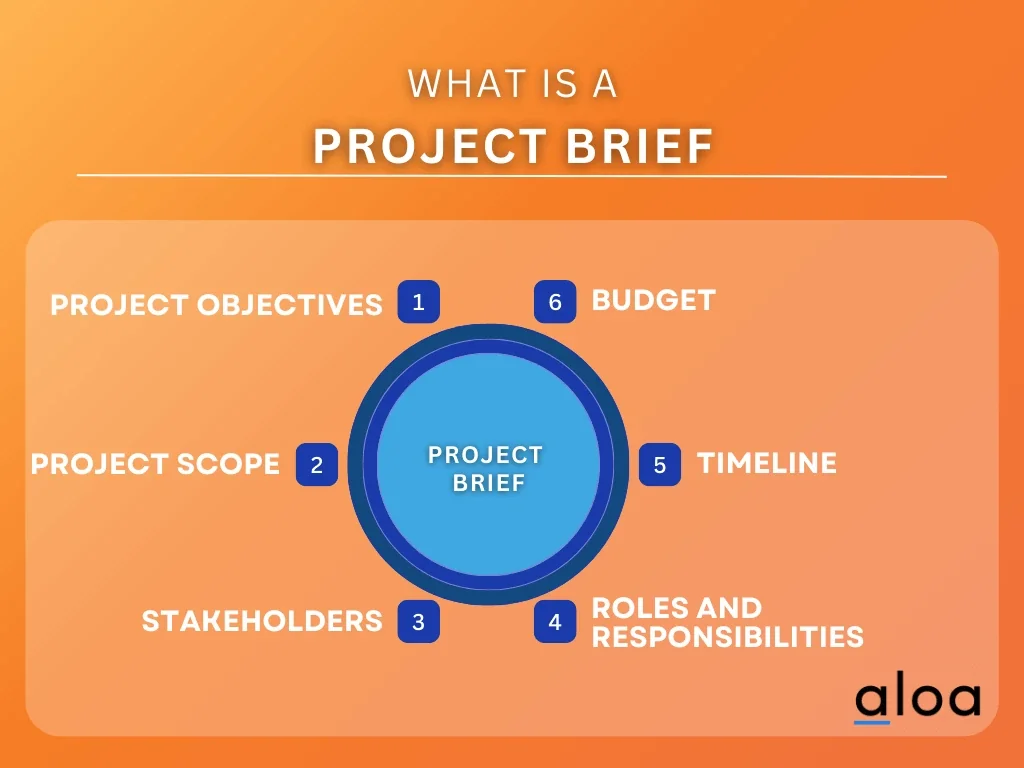
- Project Objectives: The project brief sets out the goals that the project seeks to accomplish. These objectives must be clear, measurable, attainable, relevant, and time-bound. They act as the project's north star, guiding every decision and action.
- Project Scope: The scope delineates the boundaries of the project. It outlines what the project will and will not cover, helping to prevent scope creep — the tendency for the project's requirements to expand beyond its original plans without getting proper approval.
- Stakeholders: Identifying the stakeholders in the project brief ensures that everyone with a vested interest in the project's outcome is included immediately. It could include the project team, clients, sponsors, end-users, or other individuals or groups affected by the project.
- Roles and Responsibilities: The project brief specifies who is responsible for what. It outlines the duties and tasks of each team member, thus avoiding confusion and promoting accountability.
- Timeline: A well-defined timeline is integral to a project brief. It sets out the project's key milestones and the expected completion dates, helping to keep the project on schedule.
- Budget: The brief should estimate the project's cost and outline how the resources will be allocated. It aids in managing expenses and avoiding cost overruns.
A project brief is a document and the essence of strategic planning in project management. It brings structure to the project, keeping everyone involved in the loop and driving the project toward its goals. It is a comprehensive, clear, and concise document that sets the tone and direction for the project, promoting efficiency, clarity, and success. Whether a small project or a complex multi-departmental initiative, a well-crafted project brief is invaluable in steering the project toward successful completion.
How To Make A Project Brief
Creating a project brief is a crucial first step to kick-start any project. It paves the way for effective project management, setting the foundation for successful execution. Here's a detailed guide on how to create a project brief.
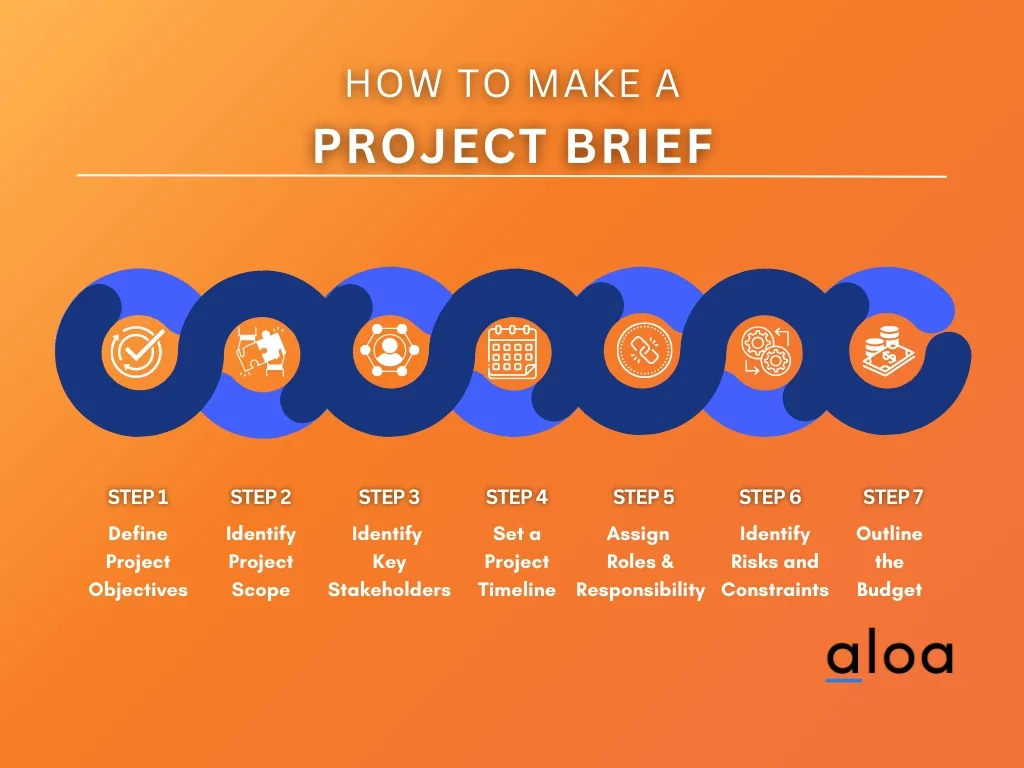
Step 1: Define the Project's Objectives
Start by clearly defining the objective or objectives of your project. What problem are you trying to solve or the result you want to achieve? Your goal needs to be clear and concise. It should also be measured to determine whether the project succeeded. For example, if you're designing a website for a client, an objective might be "Increase website traffic by 30% within six months after launch."
Step 2: Identify the Project's Scope
Next, outline the project's scope. This includes detailing what the project will deliver and what it will not. Defining the scope helps prevent scope creep and ensures everyone is on the same page about the project. For instance, in a website development project, the scope could include elements like website design, content creation, and SEO optimization but exclude aspects like social media marketing or logo design.
Step 3: Identify Key Stakeholders
Identify and list the key stakeholders of your project. These people have a vested interest in the project and its outcome. Stakeholders can include clients, team members, or higher-ups in your company. Note down their expectations and how they'll be involved in the project.
Step 4: Set a Project Timeline
Create a realistic timeline or project roadmap, including the start and end dates and the milestones. Be specific with deliverable dates, and remember to leave room for potential delays. For our website project example, milestones include completing the website design, content creation, and testing phases. The timeline ends with the launch of the website, six months from the start of the project.
Step 5: Assign Roles and Responsibilities
Identify the project team members and assign roles and responsibilities to each. A clear definition of duties ensures every team member knows their tasks, leading to a more efficient workflow.
Step 6: Identify Risks and Constraints
Every project comes with potential risks and constraints. Identify these early on to mitigate any future issues. It might be budget constraints, tight deadlines, or limited resources. For the website project, a risk could be delays in content creation or budget overruns.
Step 7: Outline the Budget
Lastly, detail the project's budget. Include all costs related to the project and factor in a contingency for unexpected expenses. For the website project, the budget might include costs for design software, content creation, and web hosting.
By following these steps, you'll have a comprehensive project brief to guide your project. An effective project brief will outline the essential project details, helping you manage your project effectively from start to finish. It aligns all stakeholders, clarifying your project objectives and setting the stage for a smooth project journey.
Best Practices for Creating a Project Brief
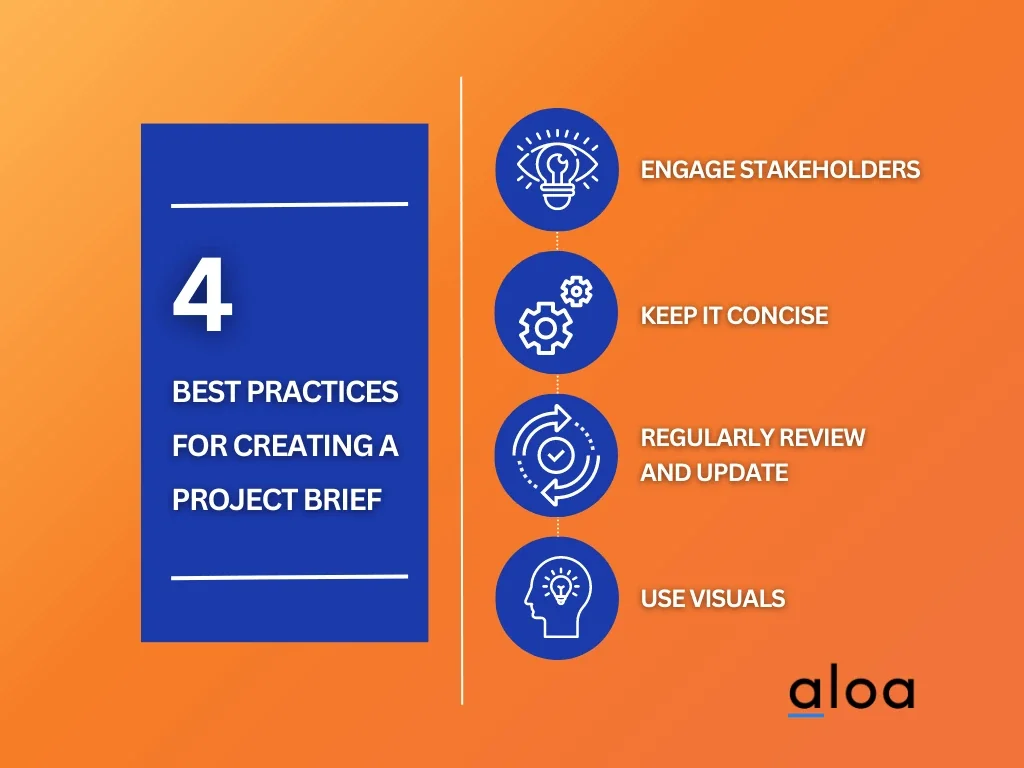
Engage Stakeholders
Involving stakeholders in creating the project brief ensures their needs and expectations are addressed. Their input can provide valuable insights that help shape the project.
Keep it Concise
While a project brief should be detailed, it must also be concise. Avoid using technical jargon that may confuse readers. Don't worry about outlining the nitty-gritty details in this document; those will be accounted for in the project plan or roadmap. Remember, a project brief is a communication tool that provides clarity, not complexity.
Regularly Review and Update
A project brief is not a static document. As the project progresses, you may need to make adjustments. Regularly review and update the project brief to ensure it remains relevant.
Use Visuals
Consider using charts, graphs, and other visuals to present information effectively. It can make your project brief, easier to understand, and more engaging.
Creating a successful project brief requires careful thought and planning. However, when done correctly, it provides a strong foundation that guides your project to successful completion.
Business Brief vs. Project Brief
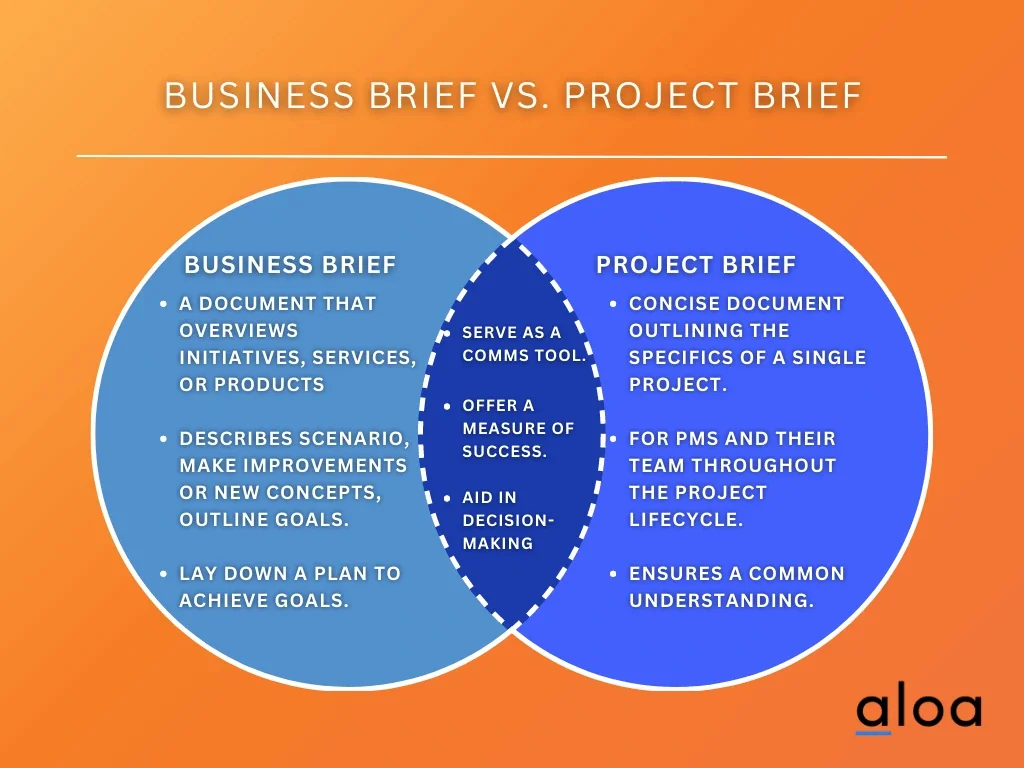
Purpose
A business brief typically addresses broader organizational issues or opportunities, providing strategic direction for the business or a specific department. It often informs business strategy or decision-making at the executive level.
Conversely, a project brief is narrower in scope, focusing on a specific project. Its primary purpose is to guide project execution, helping the project team understand the project's goals, scope, timeline, and more.
Components
A business brief includes an overview of the business or market scenario, proposed ideas or improvements, business goals, and the strategy to achieve those goals. It can also include details on resource allocation, although this is typically high-level.
In contrast, a brief outlines the project's specific objectives, scope, stakeholders, timeline, risks, constraints, and budget. It also outlines the roles and responsibilities of team members, which isn't typically included in a business brief.
Usage
In project management, a business brief might be used at the initiation phase to understand the business context of a project. However, it is only sometimes referred to throughout the project lifecycle.
In contrast, a project brief is vital throughout the project lifecycle. It is often developed at the project initiation phase and referred to continuously by the project team to guide the project's execution and to ensure alignment with the project goals.
While business and project briefs share similarities, they serve different purposes and contain different information. Understanding these differences can help ensure that these documents are used effectively to guide strategic decision-making and project execution.
Benefits Of A Project Brief For Startups
A project brief, while an initial step, is pivotal to the success of any project, especially in the world of business and startups, where the environment is dynamic and often unpredictable. It brings structure, clarity, and direction to the project, leading to numerous benefits such as improved efficiency, stakeholder alignment, and risk reduction.
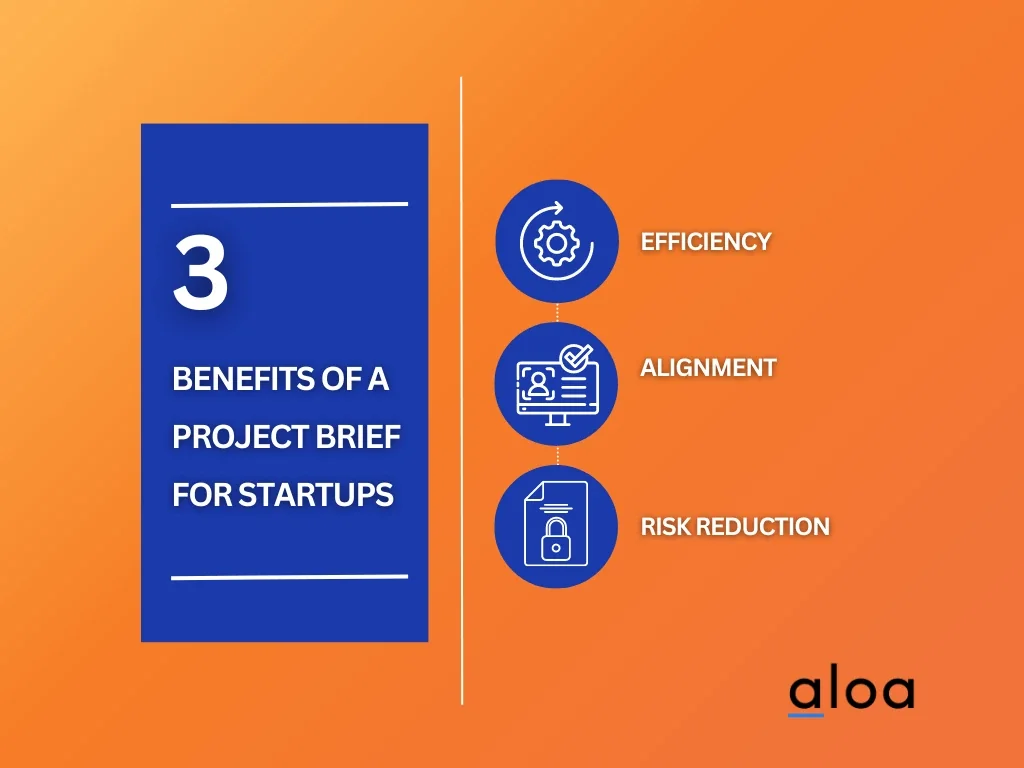
Efficiency
In project management, efficiency is paramount. A project brief is a powerful tool to enhance this. By clearly outlining the project's objectives, scope, timeline, and assigned roles and responsibilities, a project brief sets a clear path for the project team to follow. It reduces confusion and misdirection, often leading to wasted resources and time. When preparing a project brief, many professionals also rely on external writer services to ensure clear, concise, and effective communication of their project goals and requirements.
For startups, where resources are typically tight, such efficiency is invaluable. With everyone understanding their tasks and responsibilities, there is less redundancy and more streamlined workflows. As a result, projects can be executed on time and within budget, which is crucial for a business or startup's positive reputation and profitability.
Alignment
A project brief ensures alignment among all stakeholders, from the project team to the clients or executives. It provides a shared understanding of the project's goals, scope, and timeline. This is particularly important in startups, where teams often work cross-functionally, and clear communication is crucial to success. With a comprehensive project brief, everyone is on the same page about what the project aims to achieve and how it will get there. This alignment helps to avoid misunderstandings and conflicts later on, leading to smoother project execution and a more cohesive team.
Risk Reduction
Every project comes with potential risks that can threaten its success. These risks might be related to budget overruns, changes in market conditions, or project scope creep. A project brief helps in identifying these potential risks upfront. It outlines the possible challenges and constraints the project may face and offers strategies for mitigating these risks. This early identification and planning for risks are essential for businesses and startups. It means that when issues arise, they are less likely to cause significant disruptions or derail the entire project. The team is better prepared to handle the problems and keep the project on track.
A project brief is more than just a simple document. It's a strategic tool that can significantly enhance the success of projects, particularly in businesses and startups where adaptability, efficiency, and risk management are essential. A well-crafted project brief can be a game-changer in project management by improving efficiency, ensuring stakeholder alignment, and reducing risks. It's an investment of time and effort that yields substantial returns throughout the project lifecycle.
Key Takeaways
A project brief is a simple document and a strategic tool integral to project management. It can significantly enhance efficiency, ensure stakeholder alignment, and reduce project risks. The benefits it brings, particularly for businesses and startups, make it an indispensable part of any project.
If you've been managing projects without a brief, it's time to try it out! You'll be amazed at the increased efficiency, alignment, and risk preparedness you can achieve. Contact [email protected] today, and let's start building your project briefs together. With a well-crafted project brief, you're setting your project up for success from the start.

